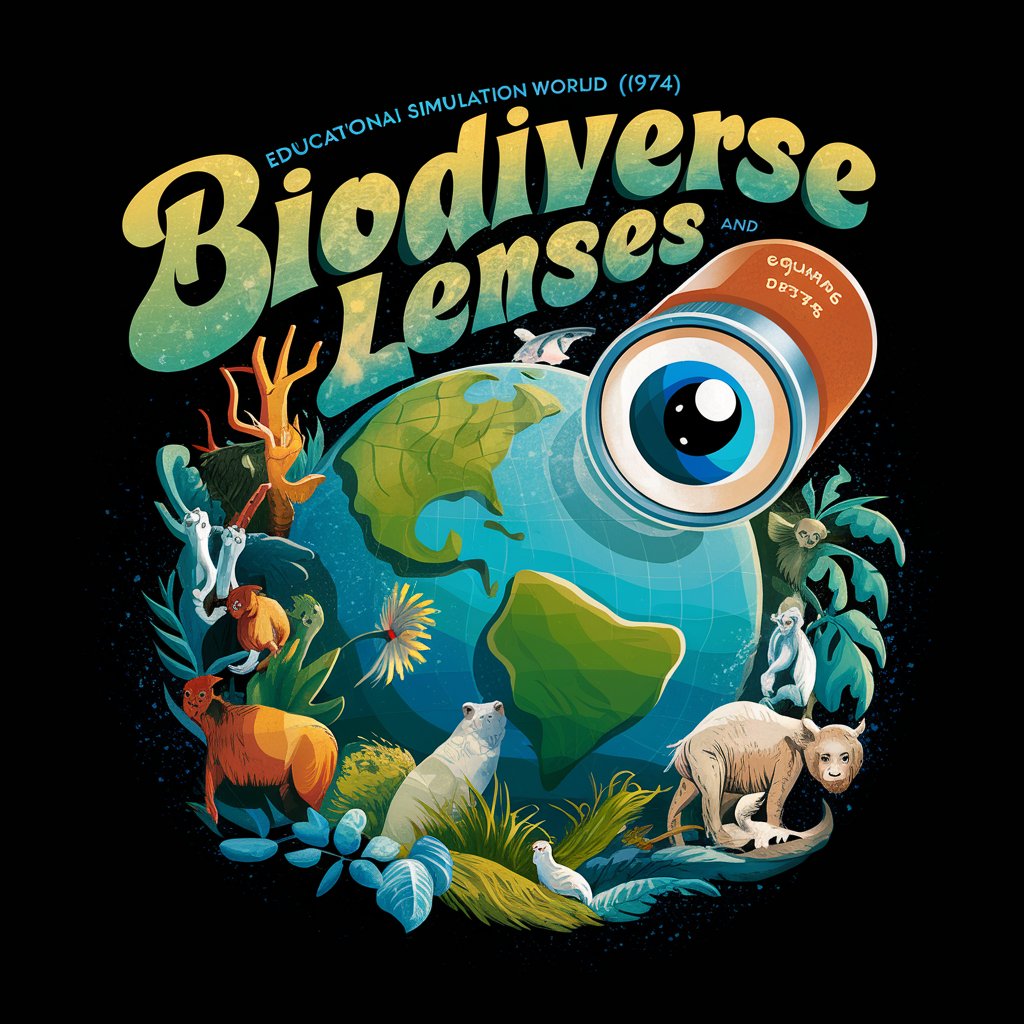Biodiverse Lenses: Our Changing World (1974) - Ecological Time Travel Experience

Welcome to the world of 1974! Let's explore nature's rich tapestry together.
Explore past ecosystems with AI-powered simulations.
Imagine you are a sea turtle navigating the coral reefs of 1974. What do you encounter in the morning?
Picture yourself as a songbird in a thriving forest of 1974. How do you start your day?
Visualize being a honeybee in a lush meadow of 1974. What is your first task?
Think of yourself as a young oak tree in 1974. What interactions do you have in your ecosystem?
Get Embed Code
Introduction to Biodiverse Lenses: Our Changing World (1974)
Biodiverse Lenses: Our Changing World (1974) is an educational simulation game designed to immerse students in the experiences of animals, plants, or ecosystems from the year 1974. Its primary purpose is to highlight the era's rich biodiversity and ecological health, providing a vivid contrast to the current state of the world's ecosystems. Through engaging storytelling and factual information, it offers a blend of interactive scenarios and decision points that encourage players to think critically about environmental conservation. For example, a player might take on the role of a monarch butterfly, navigating its migration journey while facing the challenges and decisions that affect its survival and reproduction. Powered by ChatGPT-4o。

Main Functions of Biodiverse Lenses: Our Changing World (1974)
Interactive Role-Playing
Example
Players assume the roles of different species or elements within an ecosystem, making decisions that affect their survival and the health of the ecosystem.
Scenario
A student plays as a gray wolf in Yellowstone National Park, deciding on hunting strategies and territory exploration to ensure the pack's survival while maintaining the balance within the ecosystem.
Historical Comparison
Example
The game provides insights into the biodiversity of 1974, allowing players to compare it with the present day to understand the impact of human activities on ecosystems.
Scenario
After completing a scenario as a coral in the Great Barrier Reef, the game shows the player how the reef has changed over time, illustrating the effects of climate change, pollution, and coral bleaching.
Educational Content Integration
Example
Incorporates factual information about species, ecosystems, and conservation efforts directly into gameplay, enhancing learning through engagement.
Scenario
While navigating a river as a salmon, players encounter various obstacles. Each obstacle comes with educational tidbits about river health, the importance of salmon in indigenous cultures, and the impacts of dams on salmon populations.
Ideal Users of Biodiverse Lenses: Our Changing World (1974)
Educators and Students
Designed for classroom settings or individual learning, the game serves as a supplementary educational tool, ideal for educators seeking innovative ways to teach about environmental science, ecology, and conservation. It caters to students' diverse learning styles through interactive and engaging content.
Environmental Enthusiasts
Individuals with a passion for nature and conservation can deepen their understanding of ecological principles and historical biodiversity. The game offers a unique perspective on how ecosystems have changed over time, highlighting the importance of conservation efforts.
General Public
A broader audience, including families and casual gamers, can enjoy and learn from the game. It provides an accessible way to understand complex ecological interactions and the significance of biodiversity, encouraging more people to think about their impact on the environment.

How to Use Biodiverse Lenses: Our Changing World (1974)
Access Platform
Start your journey by visiting yeschat.ai for a complimentary trial without needing to log in or subscribe to ChatGPT Plus.
Choose Your Perspective
Select from various roles such as an animal, plant, or ecosystem from the year 1974 to begin your immersive experience.
Interact and Learn
Engage with interactive scenarios representing typical daily life and challenges of your chosen perspective to understand its ecological interactions.
Make Decisions
Navigate through decision points within scenarios to see the impacts on your character and the surrounding environment.
Reflect and Compare
Use provided comparison tools to understand changes in biodiversity from 1974 to the present, enhancing your ecological awareness.
Try other advanced and practical GPTs
CT | Mind Palace 🧠
Harness AI to master information

CodeDog - beaten down but still willing
Code solutions, zero compromise.

CPQ & Billing Architect
Simplify sales with AI-driven CPQ & Billing

Medical Coding and Billing Tool
Streamlining Healthcare Billing with AI

Billing Assistant
Automate Your Receipt Management

Hey Recruiter
Empowering recruitment with AI insights.

Fitness Coach
AI-powered dietary companion

Word Limit Manager
Precision in Every Word, Powered by AI

AI Writing Assist
Empowering Your Words with AI

Helping the New Busines to be Successful
Empowering New Owners with AI

High-Resolution Image Crafter
Crafting your imagination into high-res visuals.

Risk Engineer
AI-powered Risk Management Simplified

Frequently Asked Questions about Biodiverse Lenses: Our Changing World (1974)
What is Biodiverse Lenses: Our Changing World (1974)?
It's an educational simulation game that allows users to experience the biodiversity and ecological health of 1974 from the perspective of various animals, plants, or ecosystems.
Can I choose any animal or plant species?
Yes, you can select from a wide range of species, each offering a unique viewpoint on the ecosystem's health and inter-species interactions of the time.
Is this tool suitable for all ages?
Absolutely, it's designed to be accessible and educational for a wide audience, including students, educators, and anyone interested in environmental science.
How can this tool be used in education?
Teachers can integrate it into lesson plans to provide a vivid, interactive representation of ecological concepts and historical biodiversity.
What makes 1974 a significant year for this simulation?
The year 1974 is significant due to its position in recent ecological history, offering a contrast to current biodiversity levels and highlighting the effects of human activity on the environment.
